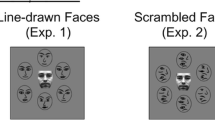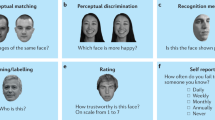Abstract
Research on face recognition and social judgment usually addresses the manipulation of facial features (eyes, nose, mouth, etc.). Using a procedure based on a Stroop-like task, Montepare and Opeyo (J Nonverbal Behav 26(1):43–59, 2002) established a hierarchy of the relative salience of cues based on facial attributes when differentiating faces. Using the same perceptual interference task, we established a hierarchy of facial features. Twenty-three participants (13 men and 10 women) volunteered for the experiment to compare pairs of frontal faces. The participants had to judge if the eyes, nose, mouth and chin in the pair of images were the same or different. The factors manipulated were the target-distractive factor (4 face components × 3 distractive factors), interference (absent vs. present) and correct answer (the same vs. different). The analysis of reaction times and errors showed that the eyes and mouth were processed before the chin and nose, thus highlighting the critical importance of the eyes and mouth, as shown by previous research.


Similar content being viewed by others
References
Abboud, H., & Sugar, D. (1997). SuperLab Pro. Phoenix: Cedrus Corporation.
Argyle, M. (1970). Eye-contact and distance: A reply to Stephenson and Rutler. British Journal of Psychology, 61, 395–396.
Cabeza, R., & Kato, T. (2000). Features are also important: Contributions of featural and configurational processing to face recognition. Psychological Science, 11(5), 429–433.
Calder, A. J., & Young, A. W. (2005). Understanding the recognition of facial identity and facial expression. Nature Reviews Neuroscience, 6, 641–651.
Cheung, O. S., Richler, J. J., Palmeri, T. J., & Gauthier, I. (2008). Revisiting the role of spatial frequencies in the holistic processing of faces. Journal of Experimental Psychology: Human Perception and Performance, 34(6), 1327–1336.
Collishaw, S. M., & Hole, G. J. (2000). Featural and configurational processes in the recognition of faces of different familiarity. Perception, 29, 893–909.
Costen, N. P., Parker, D. M., & Craw, I. (1996). Effects of high-pass and low-pass spatial filtering on face identification. Perception & Psychophysics, 58, 602–612.
Dailey, M. N., Cottrell, G. W., Padgett, C., & Adolphs, R. (2002). Empath: A neural network that recognizes facial expressions. Journal of Cognitive Neuroscience, 14(8), 1158–1173.
Donnelly, N., & Davidoff, J. (1999). The mental representations of faces and houses: Issues concerning parts and wholes. Visual Cognition, 6(3/4), 319–343.
Farah, M. J., Wilson, K. D., Drain, M., & Tanaka, J. N. (1998). What is “special” about face perception? Psychological Review, 105, 482–498.
Farivar, R., & Chaudhuri, A. (2003). I can’t see your eyes well ‘cause your nose is too short: An interactivity account of face processing. In Proceedings of the Twenty-Fifth Annual Conference of Cognitive Science Society. Boston: Massachusetts.
Freire, A., & Lee, K. (2001). Face recognition in 4- to 7-year-olds: Processing of configural, featural, and paraphernalia information. Journal of Experimental Child Psychology, 80(4), 347–371.
Greenberg, S. N., & Goshen-Gottstein, Y. (2009). Not all faces are processed equally: Evidence for featural rather than holistic processing of one’s own face in a face-imaging task. Journal of Experimental Psychology: Learning, Memory, and Cognition, 35(2), 499–508.
Halberstadt, J., Goldstone, R. L., & Levine, G. M. (2003). Featural processing in face preferences. Journal of Experimental Social Psychology, 39, 270–278.
Harel, A., & Bentin, S. (2009). Stimulus type, level of categorization, and spatial-frequencies utilization: Implications for perceptual categorization hierarchies. Journal of Experimental Psychology: Human Perception and Performance, 35(4), 1264–1273.
Hosie, J. A., Ellis, H. D., & Haig, N. D. (1988). The effect of feature displacement on the perception of well-known faces. Perception, 17, 461–474.
Ingvalson, E. M., & Wenger, M. J. (2005). A strong test of the dual-mode hypothesis. Perception & Psychophysics, 67(1), 14–35.
Itier, R. J., Alain, C., Sedore, K., & McIntosh, A. (2007). Early face processing specificity: It’s the eyes! Journal of Cognitive Neuroscience, 19(11), 1815–1826.
Itier, R. J., & Batty, M. (2009). Neural bases of eye and gaze processing: The core of social cognition. Neuroscience and Biobehavioral Reviews, 33, 843–863.
Janik, S. W., Wellens, A. R., Goldberg, M. L., & Dell’Osso, L. F. (1987). Eyes as the center of focus in the visual examination of human faces. Perceptual and Motor Skills, 47, 857–858.
Lahaie, A., Mottron, L., Arguin, M., Berthiaume, C., Jemel, B., & Saumier, D. (2006). Face perception in high-functioning autistic adults: Evidence for superior processing of face parts, not for a configurational face-processing deficit. Neuropsychology, 20(1), 30–41.
Leder, H., & Bruce, V. (2000). When inverted faces are recognized: The role of configural information in face recognition. The Quarterly Journal of Experimental Psychology, 53A(2), 513–536.
Leder, H., & Carbon, C. C. (2005). When context hinders. Context superiority versus learn-test-compatibilities in face recognition. Quarterly Journal of Experimental Psychology, 58A(2), 235–250.
Macho, S., & Leder, H. (1998). Your eyes only? A test of interactive influence in the processing of facial features. Journal of Experimental Psychology: Human Perception and Performance, 24(5), 1486–1500.
MacLeod, C. (1991). Half a century of research on the Stroop effect: An integrative review. Psychological Bulletin, 109, 163–203.
Maurer, D., Le Grand, R., & Mondloch, C. J. (2002). The many faces of configurational processing. Trends in Cognitive Sciences, 6(6), 255–260.
McArthur, L. Z., & Baron, R. M. (1983). Toward an ecological theory of social perception. Psychological Review, 90, 215–238.
McKone, E. (2008). Configural processing and face viewpoint. Journal of Experimental Psychology: Human Perception and Performance, 34(2), 310–327.
McSorley, E., & Findlay, J. M. (1999). An examination of a temporal anisotropy in the visual integration of spatial frequencies. Perception, 28, 1031–1050.
Metacreations International, Ltd. (2000). Kai’s Super Goo. Dublin: Author.
Mondloch, C. J., Le Grand, R., & Maurer, D. (2002). Configural face processing develops more slowly than featural face processing. Perception, 31(5), 553–566.
Montepare, J. A., & Dobish, H. (2003). The contribution of emotion perceptions and their overgeneralizations to trait impressions. Journal of Nonverbal Behavior, 27(4), 237–254.
Montepare, J. A., & Opeyo, A. (2002). The relative salience of physiognomic cues in differentiating faces: A methodological tool. Journal of Nonverbal Behavior, 26(1), 43–59.
Morrison, D. J., & Schyns, P. G. (2001). Usage of spatial scales for the categorization of faces, objects, and scenes. Psychonomic Bulletin & Review, 8(3), 454–469.
Rakover, S. S. (2002). Featural vs. configurational information in faces: A conceptual and empirical analysis. British Journal of Psychology, 93, 1–30.
Ruiz-Soler, M., & Beltran, F. S. (2006). Face perception: An integrative review of the role of spatial frequencies. Psychological Research, 70, 273–292.
Ruiz-Soler, M., & Beltran, F. S. (2007). Facing visual tasks based on different cognitive architectures. In K. Delac & M. Grgic (Eds.), Face perception (pp. 487–494). Vienna: I-Tech.
Schwaninger, A., Lobmaier, J. S., & Collishaw, S. M. (2002). Role of featural and configural information in familiar and unfamiliar face recognition. Lecture Notes in Computer Science, 2525, 643–650.
Schyns, P. G. (1998). Diagnostic recognition: Task constraints, object information and their interactions. Cognition, 67, 147–179.
Sergent, J. (1986). Microgenesis in face perception. In H. D. Ellis, M. A. Jeeves, F. Newcombe, & A. Young (Eds.), Aspects of face processing (pp. 17–73). Dordrecht, The Netherlands: Martinus Nijhoff.
Sergent, J. (1994). Brain-imaging studies of cognitive functions. Trends in Neurosciences, 17(6), 221–227.
Smith, M. L., Gosselin, F., & Schyns, P. G. (2004). Receptive fields for flexible face categorizations. Psychological Science, 15(11), 753–761.
Stangor, C., Lynch, L., Duan, C., & Glass, B. (1992). Categorization of individuals on the basis of multiple social features. Journal of Personality and Social Psychology, 62, 207–218.
Tanaka, J. W., & Sengco, J. A. (1997). Features and their configuration in face recognition. Memory & Cognition, 25, 583–592.
Vinette, C., Gosselin, F., & Schyns, P. G. (2004). Spatio-temporal dynamics of face recognition in a flash: It’s in the eyes. Cognitive Science, 28, 289–301.
Wenger, M. J., & Ingvalson, E. M. (2003). Preserving information separability and violating decisional separability in facial perception and recognition. Journal of Experimental Psychology: Learning, Memory, and Cognition, 29, 1106–1118.
Zarate, M. A., & Smith, E. R. (1990). Person categorization and stereotyping. Social Cognition, 8, 161–185.
Zhang, L., Garrison, W., & Cottrell, G. W. (2004). When holistic processing is not enough: Local features save the day. Paper presented at the 26th Annual Cognitive Science Conference. Chicago.
Acknowledgments
This project was supported in part by a grant awarded to the second author by the Directorate General for Research of the Government of Catalonia (2009SGR-1492).
Author information
Authors and Affiliations
Corresponding author
Rights and permissions
About this article
Cite this article
Ruiz-Soler, M., Beltran, F.S. The Relative Salience of Facial Features When Differentiating Faces Based on an Interference Paradigm. J Nonverbal Behav 36, 191–203 (2012). https://doi.org/10.1007/s10919-012-0131-z
Published:
Issue Date:
DOI: https://doi.org/10.1007/s10919-012-0131-z




